Date: 10th Century
Type of Find: Burial
Date of Excavation: 1984
Context: All beads were found in neck area with the exception of the two largest amber ones, which were found at the waist
Beads: 73 beads, 8 of which were broken
Several weeks ago in another post, I noted I would soon talk at more length about the Pagan Lady of Peel and her fabulous necklace. Since then it has been announced that the necklace will go on display in York, and numerous people have sent me the news articles for that, so I guess now is really the time to do this one.
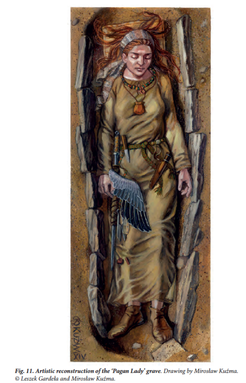 Image credit to Leszek Gardeła and Mirosław Kuźma, from the article “Viking Death Rituals on the Isles of Man”.
Image credit to Leszek Gardeła and Mirosław Kuźma, from the article “Viking Death Rituals on the Isles of Man”. In addition to the necklace of 71 beads (glass, amber and jet), with 2 amber bead-amulets, the grave also contained three knives (one of which only a hilt remains and one is noted to likely have had some sort of specialized purpose), iron shears, an antler comb, remains of a leather pouch with metal fittings and two bronze needles, an ammonite fossil (thought by Saxons to be a fertility charm), a goose wing, herbs, a possible mortar and pestle, and feather filled pillow. Additionally there were fragments of three textiles, one of which is believed to have been a sprang hairnet. There was also an item initially believed to be an iron spit, but later researchers have compared it to similar items in female graves that are thought to be seiðr-staffs, indicating that the women interred might have been a seeress or sorceress of some sort. (Price; Gardeła)
 My collage to demonstrate what the possible "otter disturbance" at the Scar burial looked like.
My collage to demonstrate what the possible "otter disturbance" at the Scar burial looked like. Did she ever wear oval brooches? We do know that by this time they were going out of fashion in Denmark, and if she perhaps came from a settlement in the British Isles, there already could have been adoption of local dress. It is also possible that she wore them in life but was not sent into the next world with the jewelry for some reason. Comparisons have also been drawn to her grave and many other status graves of the Viking age.
This particular grave is referenced in many other works, include the Scar boat burial in Orkney Scotland. This grave dates to the late 9th or early 10th century, and contained an equal-arm brooch, a wooden handled sickle, textiles (included a brocaded wool cloth), a whalebone plaque, a comb, a weaving batten, shears, a box with metal fittings, whorls, and a sickle. The wealth of this grave, as well as lack of oval brooches is the reason that comparisons are made between the two, however, the book covering the work at Scar repeatedly notes that there was an “otter disturbance” (that’s a direct quote) at the site that could have resulted in displacement or loss of the brooches. I know that if I were an otter, I think I would very much love to have shiny brooches for myself. Another correlation that could possibly be made is the völva grave from Fyrkat which also has no oval brooches.
71 one beads comprised the necklace, with 8 of them being broken. Two additional amber beads (the largest in the find) were found near the waist. The materials for the beads include glass, amber and jet and have origins in Scandinavia, Anglo-Saxon and the Mediterranean or Middle East.
One bead is faiance, and is believe to be imported from the Mediterranean or the Middle East and may well have been an antique to the Pagan Lady. There are amber beads, likely from the Baltic, in the strand, a long blue bead is considered to be an Irish ‘String’ bead. Two of the glass beads incorporate millefiori, one of this is thought to be an Eastern import.
In her thesis, “Perler fra vikingtiden”, Hickey compares beads from Peel (and other sites) to those cataloged in the Guido’s The Glass Beads of Anglo-Saxon England. Based on that possible origins for various beads include Rhineland, Rhenish, Frisian/Frankish, and more locally, Netherlands, and Scandinavia as well as many of local manufacture.
The beads were possibly collected over a lifetime and may even include some brought from her homeland in addition to prized imports. I wish that I had a better analysis of each bead in this grave, and have one more book coming to me via ILL that might have more detail. If indeed it does, I plan to post the additional information here.
If you want to see a very large image of the necklace, please visit the link for the Isle of Man museum here: https://tinyurl.com/y4f2pzd4
Another site that is worth looking at is that of Glonney Designs. The artist briefly discusses the necklace and also has two images (that I wish were much larger) of the beads laying flat, rather than strung. It better allows you to get a sense of size and same for some of the beads. I am trying to source these items in a higher resolution version, glonneydesigns.wordpress.com/category/studio/the-pagan-ladys-necklace-project/
Gardeła, Leszek. “Viking Death Rituals on the Isles of Man”, Viking Myths and Rituals on the Isle of Man, University of Nottingham, 2014.
Goodrich, Russell. “Scandinavians and Settlement in the Eastern Irish Sea Region During the Viking Age”, PhD Dissertation, University of Missouri-Columbia, 2010.
Guido, Margaret. The Glass Beads of Anglo-Saxon England: c. AD 400-700, Boydell Press, 1999.
Hickey, Megan. “Perler fra vikingtiden: A study of the social and economic patters in the appearance of beads from Viking-Age sites in Britain”, Master of Arts Research, University of York, 2014.
Holgate, Barbara. “The Pagan Lady of Peel”, St. Patrick’s Isle Archaeological Trust, 1987.
Mainman, A.J. and N.S.H. Rogers. “Craft, Industry and Everyday Life: Finds from Anglo-Scandinavian York”, The Archaeology of York, Volume 17: The Small Finds, 2000.
Miller, Ben. “Child grave goods from the Isle of Man castle and Viking beach market discoveries head to Cornwall”, Culture24, 1/27/2015.
Morris, Carole. “An Irish ‘String’ Bead in Viking York”, Bead Society of Great Britain Newsletter, 58.
Owen, Olwyn and Magnar, Dalland. “Scar: A Viking Boat Burial on Sanday, Orkney”, Tuckwell Press, 1999.
Price, Neil. The Viking Way: religion and war in late Iron Age Scandinavia. Aun 31. Uppsala, 2002.
Richards, Julian D. “Pagans and Christians at the frontier: Viking burial in the Danelaw”, The Cross Goes North: Processes of Conversion in Northern Europe, AD 300-1300, 2003.
Ruffoni, Kirsten. “Viking Age Queens: The Example of Oseberg”, Master’s Thesis, University of Oslo, 2011.
Symonds, Leigh, et. al. “Medieval Migrations: Isotope Analysis of Early Medieval Skeletons of the Isle of Man”, Medieval Archaeology, 58, 2014.
Vannin, Ellan. “’Pagan sorceress’ Viking necklace on display in York,” BBC, 2/20/2019.
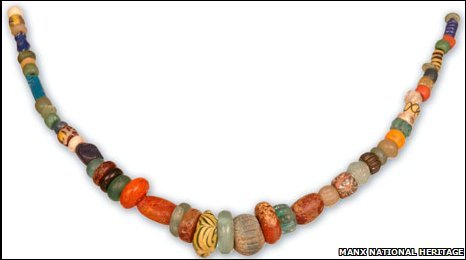
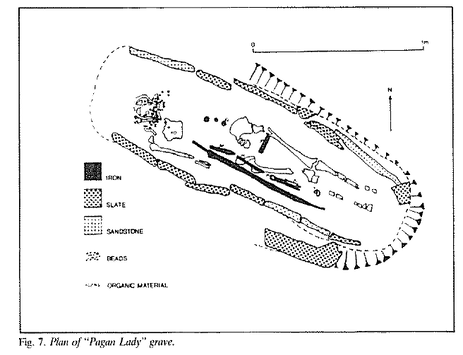
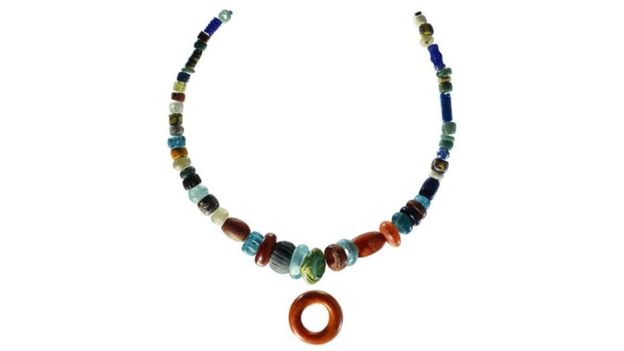
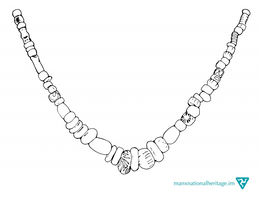
 RSS Feed
RSS Feed